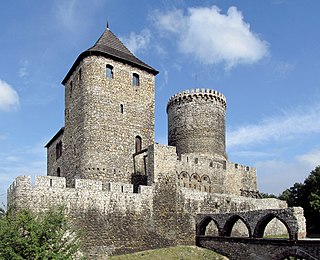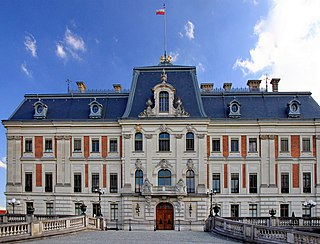
Zator is an old town on the Skawa river within Oświęcim County, Lesser Poland Voivodeship in southern Poland. From 1975 to 1998 it belonged to the Bielsko-Biała Voivodeship. The town is the administrative seat of the Gmina Zator. According to data from December 31, 2008, Zator was inhabited by 4,779 people.

The Royal Castle in Warsaw is a state museum and a national historical monument, which formerly served as the official royal residence of several Polish monarchs. The personal offices of the king and the administrative offices of the royal court were located in the Castle from the 16th century until the final partition of Poland in 1795. Situated in the Castle Square, at the entrance to the Old Town, the Royal Castle holds a significant collection of Polish and European art.

Olesko Castle is located within the borders of present-day Zolochiv Raion in Ukraine. The first historical records of the castle are in a document dated 1390, when Pope Boniface IX gave Olesko and Tustan to a Catholic bishop of Halych. It is located about seventy-five kilometers from Lviv, the largest city in western Ukraine.

The Będzin Castle is a castle in Będzin in southern Poland. The stone castle dates to the 14th century, and is predated by a wooden fortification that was erected in the 11th century. It was an important fortification in the Kingdom of Poland and later, the Polish–Lithuanian Commonwealth.

Łańcut Castle is a complex of historical buildings located in Łańcut, Subcarpathian Voivodeship, Poland. Historically the residence of the Pilecki, Lubomirski and Potocki families, the complex includes a number of buildings and is surrounded by a park. The castle is one of Poland's official national Historic Monuments, as designated September 1, 2005, and tracked by the National Heritage Board of Poland.

Pszczyna Castle is a classical-style palace in the town of Pszczyna in southern Poland. Constructed as a castle in 13th century or earlier, in a Gothic architectural style, it was rebuilt in a Renaissance style in the 17th century. During the course of the 18th and 19th centuries, the exterior of the castle was partially changed into a Baroque-Classical style. The Classicist modernization transformed the complex into what is usually described a palace.
The Dunajec river castles is a chain of thirteen medieval castles, built in southern Lesser Poland, along the Dunajec river. The castles protected the border between the Kingdom of Poland and the Kingdom of Hungary, as well as a very important international trade route, which went along the Dunajec and the Poprad all the way down to the Danube river. Most of the castles are in ruins now, and some have disappeared. Their history dates back to the period known as the Fragmentation of Poland in the early 12th century, when, according to his will, known as the Testament of Bolesław III Wrymouth, the country was divided into several provinces. The Dunajec river castles were located on the territory of two castellanies, Wojnicz and Nowy Sącz, in the extreme south of the Seniorate Province.

Brzeg Castle is located in Brzeg, Opole Voivodeship, Poland. Now a museum, the structures includes the Piast dynasty mausoleum.

The Castle of the Masovian Dukes in Płock is a Gothic castle built under the reign of Casimir III the Great, becoming a stronghold of the Dukes of Masovia until the fifteenth century. The castle is located in the Princely Capital City of Płock, Masovian Voivodeship; in Poland.

Żupny Castle is a Gothic castle, the former headquarters of the Wieliczka and Bochnia Salt Mine. The castle is located in the former mine complex and was designated as part of the Wieliczka and Bochnia UNESCO World Heritage Site, since an expansion in 2013. The castle is located in Wieliczka, Lesser Poland Voivodeship, in Poland.

Castle of Bishops in Siewierz - a castle formally housing castellans who raised the castle in the thirteenth century. The stronghold formerly fortified a hamlet in the area, which can be traced back to the origins of the Church of St. John the Baptist; now located close to the National Road No. 78 - for rapid travel to Katowice. The names of the first castellans were Jaks and Wawrzyniec. The castle is located in Siewierz, Silesian Voivodeship in Poland.

Gołuchów Castle is an early Renaissance castle built in 1550-1560 for Rafał Leszczyński on a square plan and used as a defensive stronghold and residence. The castle is located in Gołuchów, Greater Poland Voivodeship, Poland.

Grodno Castle is a castle located in the southern parts of the Wałbrzych Mountains, on the Choina Mountain, standing to the left of the river Bystrzyca. The valley of this river, formerly known as the Silesian Valley, creates a natural boundary between the Owl Mountains and to the west of it the Wałbrzych Mountains. The castle is located in Zagórze Śląskie, Lower Silesian Voivodeship in Poland.

Ojców Castle - a castle located in the Kraków-Częstochowa Upland, part of a system of castles known as the Eagle's Nests - formerly protecting the southern border of the Kingdom of Poland; currently housing a museum dedicated to the castle in its renovated castle-tower. The castle is located in the village of Ojców, Lesser Poland Voivodeship; in Poland.

Reszel Castle is a castle located in Reszel by the bank of the river Sajna, in the south-east of the town.

Oleśnica Castle is a castle in Oleśnica, Lower Silesian Voivodeship, southwestern Poland.

The Olsztyn Castle, officially the Castle of Warmian Cathedral Chapter in Olsztyn, is a Brick Gothic castle located in the heart of Olsztyn, in northern Poland. Built in the 14th century, it served as the seat for administrators of property of the Warmian Cathedral Chapter. The most well-known administrator caretaker was Nicolaus Copernicus, a canon of Warmian Cathedral Chapter in Frombork, who resided here between 1516 and 1521. The largest expository room is the refectory with a diamond vault built around 1520. Currently, the castle houses the Museum of the Warmian-Masurian Voivodeship.

Royal Castle in Szydłów is in Szydłów in Świętokrzyskie Voivodeship, Poland. The castle is located on a hill, on the bank of the River Ciekąca. The castle is located in the confinement of the town's fortification. The castle was largely used as living quarters which can be related to the interior courtyard and the large residential building.

Nowy Wiśnicz Castle – a castle located on a forested hill by the River Leksandrówka in the village of Stary Wiśnicz, Lesser Poland Voivodeship; in Poland. The castle was raised by Jan Kmita in the second half of the fourteenth century. The castle was built in the Baroque architectural style with Renaissance elements. The castle was built on the plan of the quadrilateral with the inner courtyard. The castle has four towers, with one in each corner. The castle is surrounded by bastion fortifications and the main gate from the early 17th century.




















